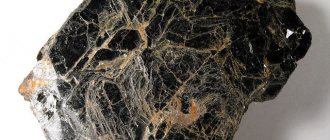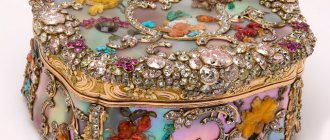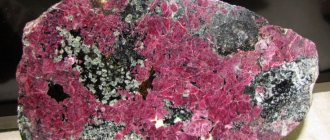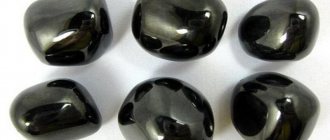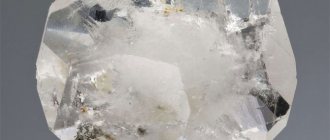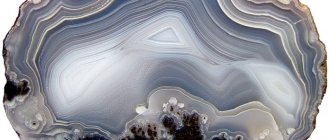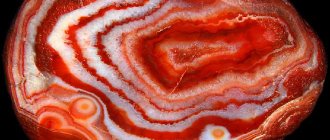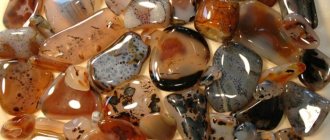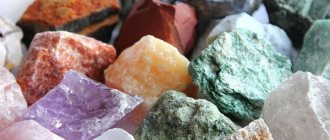Historical reference
The mineral was discovered quite a long time ago - back in 1800. Since that time, active stone mining has been carried out, especially in the Russian Federation, where a huge deposit is being developed on the Kola Peninsula and a basin is operating. The stone often exists in wide sheets in the form of a transparent hexagonal rock.
The honor of discovering and naming nepheline belongs to the French mineralogist Rene-Juste Ahuy. Having found a beautiful stone in the vicinity of Naples, the scientist, who headed the Department of Mineralogy at the Museum of Natural History, carried out a number of manipulations usual for his time, as a result of which he revealed its main properties.
Interestingly, the mineral contains a sufficient amount of water, which makes it unlike other stones. Scientists distinguish several types of minerals depending on the microimpurities that they contain in minimal quantities.
Thus, eleolith is a stone with a large percentage of fatty impurities. The composition of the mineral includes silicon in large quantities. The percentage of impurities of other metals determines its color. So, thanks to chromium, the mineral comes out green.
This interesting stone has a glassy luster and is oily at the fracture. The dense structure and increased cleavage make it durable and reliable. The sparse palette of shades tends towards transparent, cloudy, watery. This gem has some similarities with spar and quartz, but it is purely external and does not affect the characteristics of the stone as a whole.
Interesting Facts
Since ancient times, it has been generally accepted that nepheline is endowed with magical properties. It was believed that the stone is a very powerful energy protection for housing. In addition, there are beliefs that nepheline is able to protect its owner from evil and dashing glances.
It is also interesting that raw nepheline is placed under the threshold of a future house, for which the foundation has already been prepared. If the house is already ready, then the stone is suspended above the entrance.
It is believed that the power of the mineral can help its owner get to know himself better and achieve success in any activity.
Place of Birth
This mineral comes from igneous rocks. Its deposits are found all over the world.
This is interesting!
The largest deposits of stone were discovered in Russia - in the Murmansk region, in the Altai mountains, in the Krasnoyarsk Territory.
Nephelin, Odikhincha massif, Kotuy river
Nepheline deposits are also located in the following countries:
- Norway;
- Kenya;
- Tanzania;
- Sweden;
- Canada;
- Italy;
- Germany;
- Greenland.
This mineral is found in small deposits in the pores of volcanic rocks and frozen lava flows.
Description of the stone
Nepheline is a mineral belonging to the class of aluminosilicates. Crystals were first found in Naples in 1800.
Nepheline is a sol formed by potassium, silicic acid and magnesium. The mineral also contains quite a lot of water. The gem is of igneous origin, associated with processes in deep alkaline rocks.
The impurities in the chemical formula of nepheline determine its hue, and their concentration is responsible for the intensity. So, in the presence of chromium in the composition, the mineral has a green color, with manganese - pinkish, iron gives a reddish tint.
The name of the crystal is translated from Greek as “cloud”. It acquired this name because of its ability to turn into a cloudy silicic acid gel when immersed in a stronger acid.
Externally, the mineral is similar to spar or quartz, only of a more cloudy color. The surface of the stone is uneven and rough. The gem is reliable and durable in structure, but is difficult to cut and polish. The mineral is not counterfeited, since creating a fake will cost more than the original sample.
The largest deposits are located in the Murmansk and Kemerovo regions.
See what the stone looks like:
Physical and chemical properties
| Property | Description |
| Formula | (Na,K)AlSiO4 |
| Hardness | 5,5 — 6 |
| Density | 2.55 - 2.66 g/cm³ |
| singonia | Hexagonal |
| Kink | Conchoidal, uneven |
| Cleavage | Imperfect |
| Fragility | fragile |
| Shine | Fatty |
| Transparency | Translucent or opaque |
| Color | White, water-transparent, light gray, yellowish, greenish, brownish |
The physical properties of the stone are affected by the impurities of the metals included in its composition. Beryllium, magnesium, iron, calcium and other elements give the stone transparency and color it in different shades. Without these impurities, the mineral is gray or brown in color and does not have good external jewelry qualities.
Physico-chemical characteristics of nepheline
— Advertising —
By chemical nature, nepheline is a complex sodium-aluminum-silicon compound, with impurities of potassium, calcium, magnesium, and less commonly found in its composition are iron, beryllium, chlorine, and gallium.
Usually white or colorless nepheline crystals, due to the inclusion of other elements, are colored in shades of gray, green, pink, and brown. They are transparent, translucent or opaque, with a hexagonal system, imperfect cleavage, and uneven fracture. They have a rich glassy sheen.
The hardness of nepheline on the Mohs scale is 5.5-6. Density 2.55-2.66 g/cm3.
The special properties of the stone include its ability to easily decompose in acids (nitrate, sulfate, hydrochloric), and also easily oxidize in air with the formation of a loose gray crust on the surface.
Nepheline usually occurs in the form of solid granular aggregates, or short-prismatic crystals with uneven, rough edges.
Colors and varieties
Large nepheline crystal from Brazil
There are few varieties of nepheline. They are classified by color and chemical composition. Depending on the chemical properties, the following types are distinguished:
- albite;
- apatite;
- orthoclase;
- calsilite;
- nepheline hydrate;
- potassium;
- lithium;
- sodium nepheline.
The variety of shades is small:
- grey;
- borax;
- colorless;
- yellowish;
- bluish;
- pale green;
- brown;
- pinkish.
In addition to the chemical composition, the shade of the stone is also influenced by its location and depth.
Medicinal properties
Nepheline
The therapeutic effect of nepheline on humans is associated primarily with its positive effect on the state of the nervous system. The stone calms and helps relieve fatigue and stress.
In addition, staring at a nepheline crystal for a few minutes every day improves vision.
Yellow-gray nepheline normalizes the functioning of the gastrointestinal tract, increases appetite and improves metabolic processes.
In general, the stone has a tonic effect on the human body and helps in the prevention of various diseases.
Areas of application
Nepheline is used for crafts, in particular, figurines, caskets, ashtrays, and ink utensils were made from it in the past.
Apatite-nepheline ore, Khibiny
Nepheline found its use in tanning leather to give it strength and flexibility. Nepheline is used in glass and ceramics factories.
The production of green glass occurs thanks to this mineral. In the ceramics industry, nepheline easily replaces feldspar.
Glazed dishes and tiles are made using nepheline. In both cases, nepheline raw materials are supplied in the form of flour, which is obtained at mining enterprises.
The textile industry uses nepheline to impregnate fabrics to give them fire- and acid-resistant properties. To do this, the mineral is dissolved in strong acids and a glassy mass is obtained, with which the fabric is impregnated. Wood can be treated in a similar way, which will ultimately protect it from harmful external factors and extend its service life.
The main use of nepheline at present is the production of aluminum. Nepheline is the second most important mineral after bauxite, especially important in the production of alumina, which is the basis for obtaining pure metal. In addition, soda, potash, some types of sludge, and silica gel are by-products during the production of alumina.
Application of nepheline
The uses of nepheline are extensive:
- It is used as a raw material for the production of aluminum, potash, soda and alumina.
- The mineral is used in the production of cement.
- It is in demand in the ceramic and glass industries. It is used to make pottery covered with glaze.
- It is indispensable for tanning leather, as it makes it softer, more flexible and more pliable for further processing.
- Mixtures of nepheline, if fabric or wood are impregnated with them, give the material water-repellent and fire-resistant properties.
- Nepheline is useful for aviation and mechanical engineering because light alloys are produced from it.
- Evaluated the properties of the mineral and agriculture. Its powder makes effective fertilizers for soils with high acidity.
Nepheline is not in demand among jewelers, as it is difficult to process and is inferior in aesthetics to many other materials. The exception is amulets and amulets, for which the perfect cut is not so important. They are worn as jewelry.
However, nepheline is a popular ornamental stone from which craftsmen carve:
- All kinds of figurines and figures.
- Small decorative items.
- Vases.
- Inkwells and other writing instruments.
- Caskets.
- Magic balls.
- Ashtrays and much more.
Decorations and prices
Nepheline Ring
Jewelry with nepheline inserts is very rare. Not every craftsman is able to properly process this fragile mineral, and the cost of complex work is not justified by the final price of the product.
Nepheline is mainly sold in the form of crafts and rough stones. For one such nugget weighing 70-100 grams, they pay an average of $4-6. The price of crafts and polished stones increases two to three times, depending on the weight of the product.
Stone price
Nepheline ring
Raw samples or crafts made from nepheline can be purchased at an affordable price:
- $0.57 – for 10 polished beads with a diameter of 8.5 mm;
- $3-5 - for a raw crystal weighing 50-100 g;
- up to $15 - for processed gems set in jewelry alloy.
Nepheline jewelry is quite rare. In most cases, they are presented in collections in a single copy, so their cost is extremely high.
Who is suitable according to the zodiac
Nepheline jewelry is suitable for all zodiac elements, but the most favorable influence is given to the stubborn zodiac signs: Aries, Taurus.
- For Taurus – helps to establish relationships with family and work colleagues, will teach its owner to better understand other people, to be more flexible and sociable.
- For Aries - it will serve as a good talisman, allowing you to foresee troubles in advance, and will protect its owner from numerous mistakes and mistakes.
For other zodiac signs, this mineral has an average degree of compatibility. It does not help everyone, only those with whom a strong energetic connection is established.
Important!
Among the entire zodiac circle there are no signs that would be harmed by this stone. In the worst case, it will turn out to be neutral, useless.
For water signs of the zodiac: Pisces, Cancer, Scorpio, it is better to use stones of gray, brown, and white shades.
Fiery - Leo, Sagittarius, Aries, choose talismans with brown, brown, pink or red nepheline stones.
Earthly - Taurus, Virgo, Capricorn, use green or brown minerals.
The magical properties of nepheline
In magical practice, the mineral nepheline is credited with a property that helps develop the gift of clairvoyance.
A characteristic feature is the fact that raw specimens are used for rituals in magic.
They have long served as amulets for the home. They were placed, as a rule, under the threshold of a dwelling under construction.
As a talisman it is suitable for people who have creative abilities.
Talismans, amulets, amulets
Ball on a stand, Nepheline
It is most favorable to wear for people who are self-confident, purposeful in their actions, who go ahead. This mineral will allow such people to find their purpose without destroying everything in their path, avoiding all adversity and problematic situations with light humor.
Shy people are recommended to wear a nepheline talisman, which will give the owner charisma and help him find a common language with his interlocutors.
It is also important to choose the right stone shape and metal for cutting it. Career-oriented people should use figures in the form of a triangle, parallelogram, square, prism in a gold or platinum frame.
For those who have the goal of starting a family and having children, round-shaped figurines framed in gold or silver are suitable. Students, schoolchildren and people involved in science and education are recommended to wear rings with nepheline.
It allows people of creative professions to find a muse and follow the path of personal development.
Sources and literature
- Nephelin // Morshyn - Nikish. - M.: Soviet Encyclopedia, 1974. - (Great Soviet Encyclopedia: [in 30 volumes] / chief editor A. M. Prokhorov; 1969-1978, vol. 17).
- Minerals: Reference. - M.: Nauka, (2003), vol. V, issue 2, 17-52
- Samsonova N.S. Minerals of the nepheline group. M., 1973
- Yakovenchuk V.N., Ivanyuk G.Yu., Konopleva N.G., Korchak Yu.A., Pakhomovsky Ya.A. Nepheline of the Khibiny alkaline massif (Kola Peninsula). - ZRMO, 2010, part 139, issue. 2, pp. 80-91
5 / 5 ( 1 voice )
Nepheline-apatite ores
NEPHELINE-APATITE ORES (a. nepheline-apatite ores; n. Nephelin-Apatit-Erze; f. minerais de nepheline-apatite; i. minerales nefelina-apatitos) are the second type of aluminum raw material after bauxite in industrial importance. Includes nepheline and nepheline-apatite ores. The industrial value of these ores is determined by the concentration of nepheline KNa3AlSiO44, containing 29.0-35.7% Al2O3; 42.4-48.0% SiO2 and 17.0-21.9% Na2O (sodium oxide can be replaced by 10-20% by K2O). CaO, Ga2O5, V2O5, Fe2O3, etc. may be present as impurities.
Nepheline ores are dense massive igneous rocks with a volumetric mass of 2670 kg/m3, fine- and medium-grained structure. They form stocko-, daiko- and laccolith-shaped ore bodies among alkaline rocks associated mainly with ultramafic and mafic magmas.
Complex nepheline-apatite ores are a source of nepheline concentrates from their enrichment tailings, containing (%): AlO3 28.6; SiO4 44.4; Fe2O3 3.4; CaO 1.2; Na2O+K2O 17.6.
In the CCCP, industry requirements for the quality of nepheline ores are determined by conditions for specific deposits. General technical conditions for all types of nepheline ores establish the minimum (or maximum) permissible contents of the main components: Al2O3 not less than 22.5%; SiO2 no more than 45%; Na2O + K2O not less than 9.5% and Fe2O3 not more than 7%. Nepheline ores are divided into three grades based on quality. The first grade is high-quality feldspathic nepheline ores (mainly urtites), consisting of 60-90% nepheline and 10-15% pyroxene (aegirine). Their content (%) is: Al2O3 more than 26, total alkalis (R2O) more than 10, SiO2 less than 45 and Fe2O3 less than 5. They can be processed into alumina without preliminary enrichment. The second grade is nepheline-plagioclase ores (alkali-gabbroid rocks) containing 10-50% nepheline (22-25% Al2O3, 8-12% R2O and 7-10% Fe2O3). These ores require preliminary mechanical beneficiation to remove dark-colored minerals containing iron. The third grade is high-silicon nepheline-feldspathic ores (nepheline syenites), consisting of 10-30% nepheline, alkali feldspars and dark-colored components (18-24% Al2O3, 2-7% Fe2O3 and 10-14% R2O). These ores require preliminary chemical enrichment to reduce SiO2.
Mining of nepheline ores is carried out mainly by open-pit mining. Nepheline ores (urtites) and nepheline concentrates obtained from apatite-nepheline ores are processed into alumina by sintering. The ore is sintered with limestone in rotary kilns at a temperature of 1250-1350°C. After crushing, the cake is leached, and sodium and potassium aluminates pass into the solution. The aluminate solution is carbonized to decompose sodium and potassium aluminates, while aluminum hydroxide precipitates, and soda and potash remain in solution. Filtered and calcined aluminum hydroxide is a commercial product (alumina).
Nepheline ore deposits in the CCCP: Kiya-Shaltyrskoye, Goryachegorskoye, Tuluyulskoye, etc. (Kuznetsk Alatau); Mukhalskoe, Nizhneburulzaiskoe and others (Buryat ACCP), Bayan-Kola and others (Tuva ACCP). Deposits of nepheline-apatite ores are located on the Kola Peninsula - the Khibiny group (Kukisvumchorrskoye, Yuksporskoye, Rasvumchorrskoye, etc.).
Among the socialist countries, the largest deposits of nepheline-feldspathic ores are known in MHP.
Nepheline syenite deposits are found in the USA (Arkansas). Large reserves of nepheline syenite are concentrated in Canada, Norway, Portugal, Italy, Mexico, Brazil, North African countries, etc. These deposits are considered as potential sources of aluminum raw materials.
